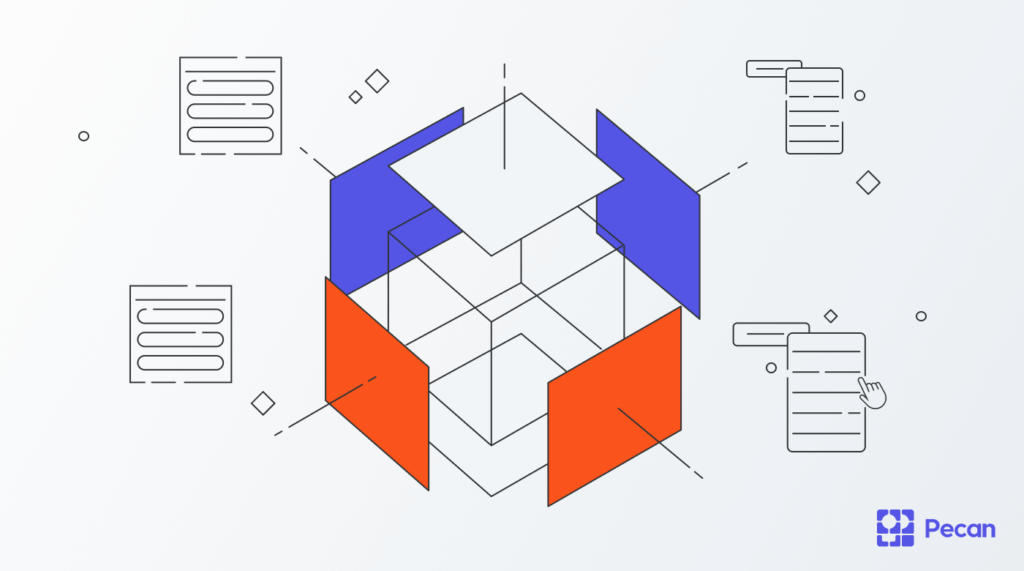In a nutshell:
- Data-driven decision-making is crucial for understanding customer behavior and improving business operations.
- Benefits include increased success, informed decision-making, and real-time insights.
- Challenges include managing massive data volume, ensuring data accuracy, and high implementation costs.
- Embracing a data-driven culture involves asking the right questions, using the right tools, and promoting a data-driven mindset.
- Democratizing data access and fostering collaboration are key to creating a successful data-driven organization.
Imagine you're managing a retail chain with online shops. You offer your customers a unique loyalty card that can be used online. The card stores the customers' actions and data in your database.
The data you collect is key to understanding how loyal customers are, how frequently they buy the product, and their purchasing power.
But it's more than that. With data, you can tweak your strategic plan just right. Then, you'll be on your way to a successful, customer-centric business.
But let's be real — collecting tons of data will not provide immediate results. You need to understand the benefits. Identifying the areas where your company can benefit most from data is key.
This article will help you learn more about data-driven decision-making, its key benefits, its challenges, and how you can implement such solutions. Your business will thank you for it.
What is data-driven decision-making?
Data-driven decision-making entails strategic decisions based on facts, metrics, and collected information. The opposite of this approach relies on intuition or guesswork.
Before making data-driven decisions, you have to extract all the relevant information from the data and analyze it properly. Also, everyone in the organization must have access to reliable and accurate data.
And, of course, the data should be easy for everyone to understand. Think of it like making a smoothie — you need the right ingredients and blend.
Organizations are increasingly making data-driven business decisions because it is the key to unlocking the latest trends and patterns.
Data also allows businesses to anticipate opportunities and risks before taking relevant action. For instance, Pecan AI solutions can allow your executive team to get a window into customers' future activity so they can plan proactively instead of analyzing past data.
Plus, businesses making data-driven decisions can evaluate the effectiveness of the strategies implemented and see the real impact of their decisions.
Benefits of a data-driven approach
But why is it worth making the effort to build a data-driven organization at all?
Transforming into a data-driven organization contributes to the overall improvement of its operation.
Data-driven companies are more successful
By 2025, 70 percent of public companies that do better than their competitors on financial metrics will use a data-driven approach.
Google uses data to improve organizational performance by identifying behaviors that shape satisfied managers. Top management then uses this information to stimulate engagement among managers and encourage them to stay longer at the company. This ultimately led to the reduction of Google's acquisition costs.
Netflix is also about that data life. They peek into our watching habits, create personalized content, and produce new shows we can't resist.
Spotify dives deep into user preferences. They collect mountains of data that help them answer the question, "How can we offer you new personalized playlists every day?"
Finally, Amazon, a digital shopping wizard, uses data to inform its strategy. Reviews, popular products, buying habits — they collect it all. The platform is the personal shopper who truly understands you.
Making informed decisions
Next, a company's success depends on its ability to make the right decisions. Using data helps organizations accurately detect problems. For example, if you're running an online store and realize that carts are constantly abandoned, analyzing data can help.
The information can indicate which stage of shopping causes the most abandoned carts or what products are frequently abandoned. This will help implement targeted solutions.
Checking in on your customers regularly can also help understand their behavior, spot trends, and nip dissatisfaction in the bud. That’s why many companies are striving to be data-driven. Sixty-five percent of B2B sales organizations will be making data-driven decisions by 2026.
You can trust data
Now, let's talk about trust. Many concepts, like "predictive analytics" or "smart data," describe data-driven decision-making. Each of them is based on the same principle — that data does not lie, while intuition can sometimes be misleading.
However, this does not mean that decision-makers should ignore their intuition. They can use their intuition alongside the data. It is also up to them to choose and interpret relevant key performance indicators.
Data-driven decision-making is, therefore, not about blindly relying on facts and figures but about integrating them into the process and subtly combining experience and data analysis to make the right decisions.
Also, with data, decisions are not made by an individual. On the contrary, everyone can trace and understand the decisions. This is especially true if all stakeholders have access to the relevant data.
Make decisions in real time
Being data-driven means riding the waves of trends and patterns, which is common in a dynamic business environment.
It is also easier to explain data than intuition, making the decision-making process faster. As a result, the company gains a competitive advantage. This is especially true in fields that rely on hard facts like shipping.
Let's take a classic example of a decision by a carrier that best meets a business's requirements. To choose the best one, you will need data regarding quantities, lead times, available capacities, and costs. If all the data is available, you can choose the best carrier with minimal effort and in record time.
Understand customer behavior
Businesses can use data to understand customer behavior and anticipate their needs. It can also be used to tailor campaign interactions and sales behavior.
There are many indications that organizations that rely on data to understand customers achieve their data-driven marketing objectives.
Here's proof — Ulta Beauty, a cosmetics retailer, used data to prepare personalized marketing campaigns. As a result, customers gained access to recommendations based on their preferences, and Ulta Beauty gained a 317 percent increase in click-through rates.
This kind of personalization can also be achieved through predictive analytics, like cross-selling and upselling predictions.
Challenges of embracing a data-driven approach
Transformation into a data-driven organization comes with many benefits, but it is also associated with many challenges. The most pressing issues that companies face when collecting data are discussed below:
Massive data volume and complexity
Most businesses are drowning in a sea of data. Data will reach 181 zettabytes by 2025. Managing such diverse and extensive data quality can be challenging for any company.
Data integration
Organizations have data from all corners — different systems, departments, and external sources. Integrating this data to create a unified and accurate view can be complex.
Further, incompatible data formats, different data structures, and conflicting definitions can complicate the integration process and compromise data quality.
Data accuracy and completeness
Ensuring data accuracy and completeness remains a challenge. Incorrect or incomplete data can cause faulty analysis, wrong decisions, and potential financial losses.
Identifying and repairing data errors and filling gaps requires robust data validation and verification processes.
Data governance and accountability
A lack of clear structures can lead to data chaos, including inconsistent definitions, redundant data, and isolated silos.
Businesses need solid policies to ensure that responsibility for data is in the right hands.
Unclear collection methods
Have you tried assembling IKEA furniture without a manual? That's what unclear data collection methods are like.
To avoid chaos, organizations need clear data collection methods to ensure the data is organized and can be used properly for analysis.
High costs of implementation
Talking about becoming data-driven is easy. Implementing it? Not so much.
The high costs of implementation and coordination can be a real hurdle. But with proper planning and patience, you can become a data-driven organization.
Time-consuming
Transforming into a data-driven company is a slow and painful process. For many companies, this is a difficult barrier to overcome.
Embracing a data-driven culture
Would you like to transform into a data-driven company? Get ready because it’s a long journey.
The development and implementation of the technology itself can take months if not years. It can take even longer to change the attitude of employees and partners. But we’ve got some tips that will make it easier.
Ask the right questions
Before embarking on the major transformation of your organization, ask yourself the right questions. The answers to your questions should help you:
- Identify the problems your business is facing.
- Check the employee’s level of awareness.
- Identify the tools that you have to collect and analyze data.
- Identify the skills your organization lacks and which would allow you to better collect, exploit, and analyze data, again, at all levels of the company.
Use the right tools
To encourage a data-driven organization mindset, you must start by collecting and using data! To achieve this, it is important to equip yourself with infrastructure and tools to make information available, accessible, and understood by everyone.
The idea is to have a single data source on which all employees can rely to make their decisions.
Employees can use data preparation tools to help them gather and clean data. The data can later be analyzed and used to make decisions.
For predictive analysis, select a tool that combines all your needs. Pecan can help with predictive analytics without heavily investing in data scientists or complex software.
Promote a data-driven culture
It's not enough to buy the latest software to make your business a data-driven organization. Sorry. Beyond investing in tools or systems, it is also essential to invest in people.
From the start, identify the right people and give them the necessary tools and training. It's important to make sure you have people familiar with the processes needed to collect the data, understand it, and present it correctly.
You may need to hire a data analyst or even a team of data specialists. You can also call on companies specializing in data for support and advice.
Better yet, you can train employees to use the tools and environments put in place because all the data in the world will have little impact without someone questioning and interpreting it.
Further, break down silos and encourage collaboration between departments, professions, and hierarchical levels.
Ensure everyone can access data
If data remains in the hands of a few people, you won't get anywhere. You need to democratize data access so that all company stakeholders can benefit from it.
Data visualization tools and platforms are particularly useful in facilitating this access. With Pecan, teams can collaborate on models and feed predictions into their shared tools of choice.
When transforming into a data-driven company, remember it’s not just about numbers. It’s about creating a culture where everyone uses data when making decisions.
To sum up
If you’re a business manager, using predictive analytics rather than intuition will help you make the right decisions.
Predictive analysis can help you make informed decisions, optimize processes, make real-time decisions, and understand consumer behavior.
Still, there are some barriers you will face when trying to create a data-driven business. They include massive data and complexity, data integration, accuracy, and completeness. Others include data governance and accountability, unclear data collection methods, high costs of implementation, and lack of time.
Overcoming these barriers will not happen overnight. Data-driven organizations have to take inventory, set up infrastructure, and actively promote a data-driven culture.
Not only that, but the organization needs to encourage collaboration between departments and invest in employee training to develop a real data culture at all levels.
Schedule a demo today to see how Pecan Al can help you develop a data-driven strategy. We’ll help you take the guesswork out of your growth.








